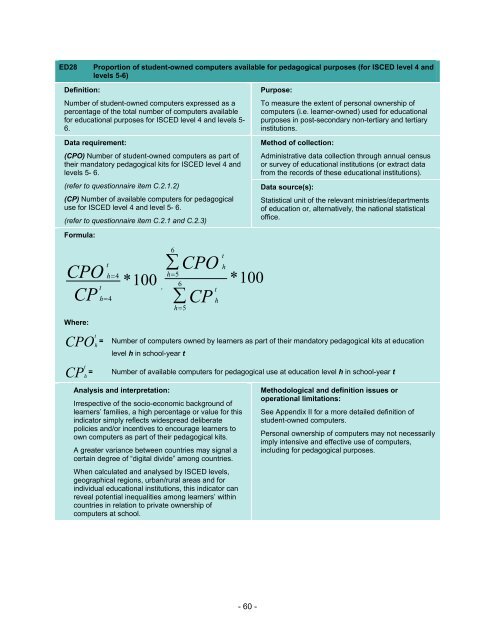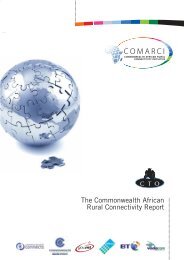Guide to measuring information and ... - unesdoc - Unesco
Guide to measuring information and ... - unesdoc - Unesco
Guide to measuring information and ... - unesdoc - Unesco
Create successful ePaper yourself
Turn your PDF publications into a flip-book with our unique Google optimized e-Paper software.
ED28 Proportion of student-owned computers available for pedagogical purposes (for ISCED level 4 <strong>and</strong><br />
levels 5-6)<br />
Definition:<br />
Number of student-owned computers expressed as a<br />
percentage of the <strong>to</strong>tal number of computers available<br />
for educational purposes for ISCED level 4 <strong>and</strong> levels 5-<br />
6.<br />
Data requirement:<br />
(CPO) Number of student-owned computers as part of<br />
their m<strong>and</strong>a<strong>to</strong>ry pedagogical kits for ISCED level 4 <strong>and</strong><br />
levels 5- 6.<br />
(refer <strong>to</strong> questionnaire item C.2.1.2)<br />
(CP) Number of available computers for pedagogical<br />
use for ISCED level 4 <strong>and</strong> level 5- 6.<br />
(refer <strong>to</strong> questionnaire item C.2.1 <strong>and</strong> C.2.3)<br />
Formula:<br />
CPO<br />
t<br />
CP<br />
Where:<br />
CPO t<br />
h<br />
t<br />
h4<br />
h4<br />
* 100<br />
,<br />
6<br />
CPO<br />
h5<br />
6<br />
CP<br />
h5<br />
t<br />
h<br />
t<br />
h<br />
* 100<br />
- 60 -<br />
Purpose:<br />
To measure the extent of personal ownership of<br />
computers (i.e. learner-owned) used for educational<br />
purposes in post-secondary non-tertiary <strong>and</strong> tertiary<br />
institutions.<br />
Method of collection:<br />
Administrative data collection through annual census<br />
or survey of educational institutions (or extract data<br />
from the records of these educational institutions).<br />
Data source(s):<br />
Statistical unit of the relevant ministries/departments<br />
of education or, alternatively, the national statistical<br />
office.<br />
= Number of computers owned by learners as part of their m<strong>and</strong>a<strong>to</strong>ry pedagogical kits at education<br />
level h in school-year t<br />
CP t<br />
= Number of available computers for pedagogical use at education level h in school-year t<br />
h<br />
Analysis <strong>and</strong> interpretation:<br />
Irrespective of the socio-economic background of<br />
learners’ families, a high percentage or value for this<br />
indica<strong>to</strong>r simply reflects widespread deliberate<br />
policies <strong>and</strong>/or incentives <strong>to</strong> encourage learners <strong>to</strong><br />
own computers as part of their pedagogical kits.<br />
A greater variance between countries may signal a<br />
certain degree of “digital divide” among countries.<br />
When calculated <strong>and</strong> analysed by ISCED levels,<br />
geographical regions, urban/rural areas <strong>and</strong> for<br />
individual educational institutions, this indica<strong>to</strong>r can<br />
reveal potential inequalities among learners’ within<br />
countries in relation <strong>to</strong> private ownership of<br />
computers at school.<br />
Methodological <strong>and</strong> definition issues or<br />
operational limitations:<br />
See Appendix II for a more detailed definition of<br />
student-owned computers.<br />
Personal ownership of computers may not necessarily<br />
imply intensive <strong>and</strong> effective use of computers,<br />
including for pedagogical purposes.
















